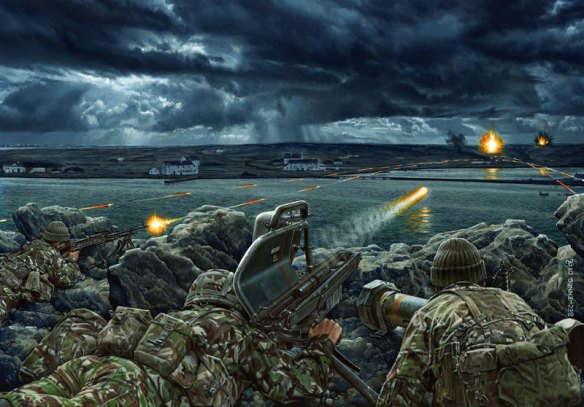Milan – RAID SAS – Darwin Settlement. Painting by Daniel Bechennec.
Visit Daniel’s Website for some fantastic Paintings
During this time the SBS and SAS had been working independently to gather information on enemy dispositions along the intended routes of both brigades. On 1 June G Squadron SAS had moved into the Mount Vernet area close to Long Island Mount. This soon led to a clash with an SBS patrol in the same area, which had been dropped off by a Sea King some miles from where it should have been, leading to the death of one SBS man. 3 The patrols were moved further east in order to identify a suitable base area. The entire ridge line of the Murrell River north of Stanley was found to be clear of major enemy forces. Having briefly deployed into this area, the lack of any substantial enemy presence led to the Squadron withdrawing on the night 6/7 June, leaving two patrols on Beagle Ridge observing the landings by transport aircraft at Stanley airport and the enemy’s dispositions on Wireless Ridge. When the main battle came they would be joined by a party that would control naval gunfire with great efficiency against targets behind the main Argentine defence line. There they stayed, undetected, until after the surrender, providing a remarkably accurate picture of the Argentines’ situation.
The gunfire planned for 9 June was cancelled the previous day well before the attack on Sir Galahad and Sir Tristram because 5 Infantry Brigade was not ready. On the night of 10 June, Active on the southern gunline fired 84 rounds at a company position on Mount Harriet, an ammunition dump near Moody Brook, and another troop position on Mount William, and this was effective. Less so was that by Arrow to the north. Meanwhile Cordella and Pict were inside Berkeley Sound carrying out their MCM task. No mines were found and they reported back that there was low risk to ships engaging in naval bombardment.
Early on 11 June, a Wessex 5 from Teal attacked the Town Hall and police station on Stanley’s waterfront with one AS12 missile and great accuracy after the SAS had established that it had some military headquarters’ function. Another missile malfunctioned and hit the water uncomfortably close to the hospital ship Bahia Paraiso. The helicopter escaped as it came under fire but the Argentine defences managed to shoot down one of their own helicopters. At 1130Z, four Sea Harriers braved Argentine air defences around the airport in order to deny it to Pucaras for the coming battle. They tossed twelve 1,000lb VT-fused bombs onto Stanley airfield. Eleven exploded as planned on or above the runway causing fires and damaging a Pucara in the dispersal area, but they did not stop other Pucaras using the runway later that day.
By the time the battle was ready to start that evening, Yarmouth, Avenger and Glamorgan were on the southern gunline in direct support of 3 Para, 42 Commando and 45 Commando, while Arrow was in Berkeley Sound to cover the airfield and other targets near Stanley, controlled by the spotter on Beagle Ridge. Ships were to be ready for the first call for fire by 2359. They had to wait until called to fire their guns, as the initial advance of the attacking troop would be silent. Expenditure per ship was limited to about 300 rounds because of the availability of ammunition for re-supply and barrel life of some guns. Over that night they would fire a total of 788 rounds, by far the heaviest bombardment of the war so far. The gunfire, with land based artillery, was directed at reported troop positions on Mount Harriet, Mount Longdon, Wireless Ridge and west of Stanley. One bombardment at 0425Z on 11 June detonated an enemy ammunition dump on Mount Harriet.
The results were impressive, marred by a stray round landing in Stanley, killing two civilians and wounding some others. A third died three days later. John Smith wrote in his diary, that night `was the most incredible, frightening one yet. Hundreds of shells were fired, which screamed and whistled over the town for hours on end-it’s non-stop’. By 0530Z Arrow had completed its task, and Glamorgan and Yarmouth stopped just over half an hour later. Avenger remained on the gunline.
